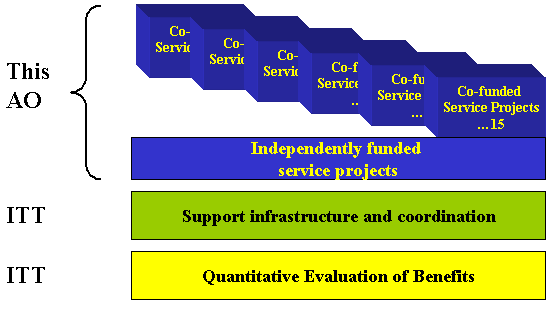|
Space Weather Applications Pilot Project
Overview | SDAs | SWENET | SWWT Role
Pilot Project Overview 
The space weather applications pilot project seeks to expand the results of the two parallel space weather programme feasibility studies and further develop the community of informed space weather service users in Europe. This will take place through outreach activities, collaboration and the development of key space weather applications based on existing or easily adaptable sources of data.
The project is anticipated to last for a period of 2 years and will include three complimentary parts:
- A number of targeted service development activities (SDAs) with strong user participation
- A network and support infrastrucure responsible for coordinating and providing technical support to the SDAs where appropriate
-
A quantitative assessment of the benefits experienced by European users as a result of the SDA development and the level of economic benefit future programme elements would bring.
The planned scheme is illustrated in the following figure:

Figure 1: Co-funded service projects will focus on a wide variety of key space weather application areas. These will be integrated by a further service support infrastructure. An independent economic analysis will also take place in order to assess the benefits provided by the pilot project services.
Service Development Activities (SDAs) 
The network will incorporate 17 ESA co-funded SDAs and a number of additional independently funded SDAs, each focusing on a wide range of space weather user domains. Each of these projects will develop services and capablities addressing the needs of specific users. In each case, the users involved will be invited to participate in an evaluation of the service and thus contribute to the economic analysis of existing and potential future space weather services.
Confirmed service development activities (SDAs) fall within the following sectors:
- Solar monitoring and warnings
- Spacecraft Hazards
- Operational Airline Risks
- GNSS Reliability
- Ionospheric Forecasting and Nowcasting
- Use of Space Weather Data in Natural Hazard Warnings
- Geomagnetic Index Forecasting
- GIC simulation and prediction
- Aurora Tourism
You can access a short summary of each confirmed SDA here
It should be noted that the above list does not cover all aspects of space weather and ESA welcomes the participation of additional space weather related service activities in the network on an independently funded basis. For more information about participation in the SWENET network contact Alain Hilgers or Alexi Glover.
Each service is closely linked with at least one user. Users represent a variety of domains including:
- private companies,
- the scientific community,
- space agencies,
- national military organisations,
- amateur astronomy groups and
- the general public
The SWENET Network 
In addition to the individual service activities, a service support infrastructure will be created named the "Space Weather European Network" (SWENET). This activity will provide support to the SDA activities, with a view to linking the individual activities to form a coordinated network of European space weather services. SWENET will have the following main objectives:
- Federate existing and newly created space weather service activities
- Assist in the development of a common network and develop the associated software infrastructure
- Provide support to the SDA activities and encourage common development
- Undertake public outreach activities promoting the pilot project outside the existing space weather applications community
- Assess user requirements for future development and identify technology requirements: especially in terms of space based measurements.
Click here to access the SWENET area
Benefit Assessment 
A third aspect of the pilot project will be an independent benefit analysis of a European space weather service. This contractor will liaise with each of the SDA activities in order to understand the user requirements in each case and the benefits gained by each user as a direct result of the SDA service on completion of the project. This information will be used to prepare a roadmap for future space weather applications business strategy.
The Space Weather Working Team (SWWT) 
The SWWT will continue to advise ESA on the progress of space weather activities within Europe. The SWWT will meet at 6 monthly intervals at which the progress of the pilot project SDAs will be discussed. SWWT membership is open to any* individual affiliated to an institution and/or private company currently undertaking space weather related activities. Members of the space weather community not currently involved in SWWT activities but interested in joining a restructured SWWT are invited to contact Alexi Glover, mentioning in which of the domains their primary space weather interests lie.
* at present this is restricted to institutes and private companies based in ESA member states. However, members of the space weather community from countries not in this category are welcome to participate in meetings and can register to be informed of SWWT meetings and actions.
|